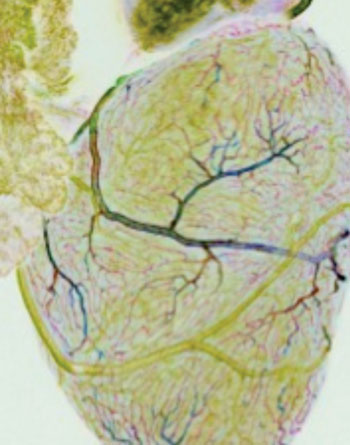Zebrafish Embryo Model Helps Explain How Coronary Blood Vessels Develop
By LabMedica International staff writers
Posted on 11 Jun 2015
Developmental biologists have used a zebrafish embryo model to study the factors that control the formation and maturation of coronary blood vessels.Posted on 11 Jun 2015
Zebrafish have become an important vertebrate model for cardiovascular research, as these animals have the ability to regenerate their heart if damaged, and because the transparency of the embryos allows easy observation of internal processes like blood vessel development.

Image: Coronary vasculature in zebrafish (Photo courtesy of Children\'s Hospital, Los Angeles).
Investigators at Children’s Hospital Los Angeles (CA, USA) used confocal microscopy and time-lapse imaging to visualize development of coronary vessels in zebrafish embryos. They reported in the May 26, 2015, issue of the journal Developmental Cell that coronary vessels sprang from the endocardium, specifically from the atrioventricular canal, the structure that divides the heart into compartments.
At the molecular level the investigators learned that endothelial cells expressing the chemokine receptor Cxcr4 (C-X-C chemokine receptor type 4) migrated to vascularize the ventricle under the guidance of the myocardium-expressed ligand Cxcl12 (C-X-C motif chemokine 12). Mutant zebrafish lacking Cxcr4 failed to form a vascular network, whereas ectopic expression of Cxcl12 ligand induced coronary vessel formation. Importantly, Cxcr4 mutant zebrafish failed to undergo heart regeneration following injury.
“This furthers our efforts into heart regeneration to repair human hearts,” said senior author Dr. Ching-Ling Lien, assistant professor of cardiothoracic surgery at Children’s Hospital Los Angeles. “We have now found a novel source of cells that can differentiate into coronary vessels and have identified the factors required.”
“Children or young adults may not be aware of having abnormal coronary vessels because their circulation is adequate until the heart is stressed by increased demands, for instance when participating in strenuous sports,” said Dr. Lien. “Then suddenly, an apparently healthy, young person dies. Alternatively, a person with abnormal coronary vessels might have higher risk of experiencing heart attacks later on in life. Our findings will guide future study toward understanding these devastating conditions in order to be better able to diagnose them and develop interventional strategies.”
Related Links:
Children’s Hospital Los Angeles













